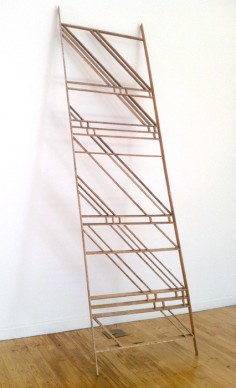ANDY VOGT
Shadeshape

source: andyvogt
‘drawn out’ was part of 3020 Laguna- a group installation project within a condemed residential house in San Francisco. Curators David Kasparzak and Amir Mortazavi stipulated that no materials besides the house itself be used in the creation of the work. I chose to cut through the wall and floor of the dining room and connect the two openings.
Andy Vogt grew up in the suburbs of Washington DC. He earned his BFA from Carnegie Mellon University concentrating in Intermedia, a program focused on time based media, performance and installation.
While at CMU he received a Student Undergraduate Research Grant to photographically document elements of nationalism in pre-EU eruope. More recently his photographs have appeared in Wired, Rolling Stone and Spin magazines as well as the covers of several albums produced by independent record labels. (a website of vintage photographs can be found here)
He is a founding member of Operation Re-Information (ORI), a science+information / art performance collective that championed the repurposing of existing information and the resultant product: reinformation. Throughout the 1990’s ORI toured nationally, recorded several cds and developed it’s own performance software.
.
.
.
.
.
.
.
.
source: inthemake
Anything can be imagined. That is something I knew to be true as a child—when the world still felt too big and there was so much I didn’t understand. But then you grow-up and things are explained, and everything that surrounds you becomes more knowable, more recognizable, and somehow fixed. But I’ve come to realize anything can be RE-imagined and the ability to do this in the world despite established meaning is often at the heart of art making.
Andy’s work takes the most common of throwaway materials and reworks its purpose and form— he finds and retrieves laths, long thin pieces of wood used in walls and ceilings to support plaster, from dumpster bins and employs them to construct sculptures that ask us to reconsider material and space and challenge the way we arrive at recognition and understanding. In Andy’s work a piece of lath becomes an endless line, a way to draw with dimension, texture, and a distinct tonal palette– his often site specific pieces are composed of intersecting, angled planes of wood that intervene and interact with pre-existing architecture and natural light, lending us a unprecedented frame to see our environment anew.
When talking with Andy he mentioned that in many ways he sees his work as premonitions of decomposition; that there is an inescapable awareness of structures in shifting states, in degradation, in collapse. A palpable eeriness resides in his forms, giving rise to feelings of uncertainty and uneasiness— feelings that so often emerge when there is a convergence of both the known and unknown. The concept of the familiar giving rise to the unfamiliar is considered in Sigmund Freud’s 1919 essay “The Uncanny”— in which he identifies the uncanny as “that class of frightening which leads back to what is known of old and long familiar.” By re-considering architectural possibility and dumpster finds, Andy’s work encourages material and space to take on new incarnations, yet without allowing them to fully shed their previous histories. This is what I find most powerful about Andy’s work— that he makes room for the ghosts; that in re-imagining he also simultaneously reveals what once was.

